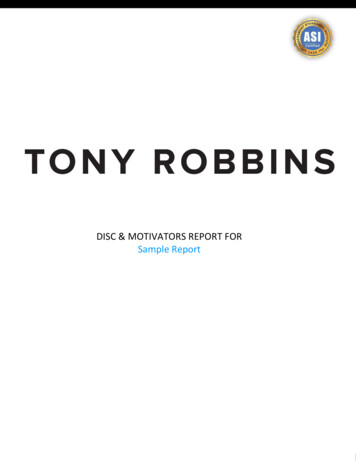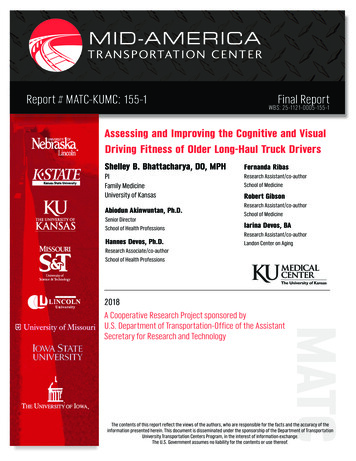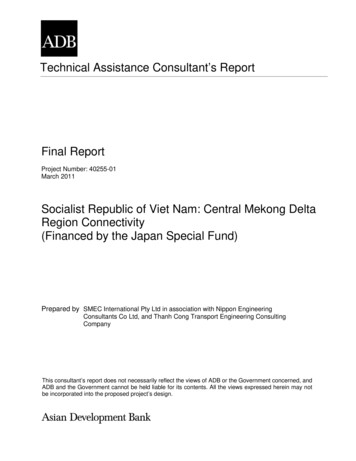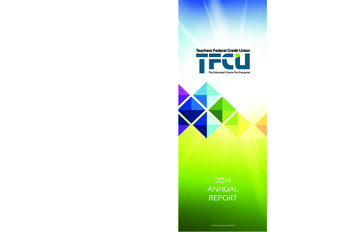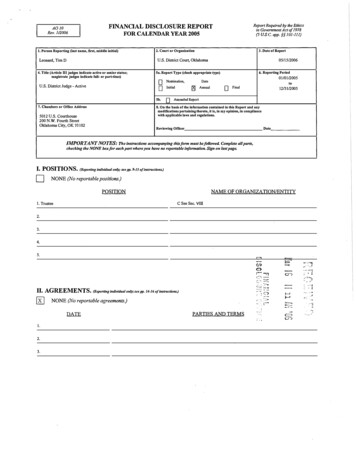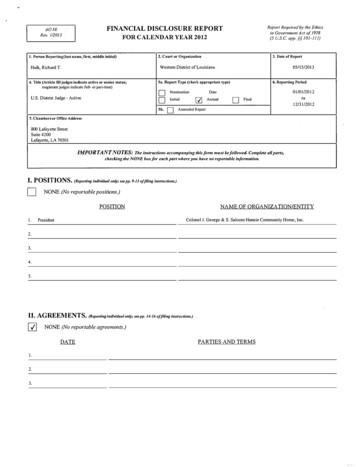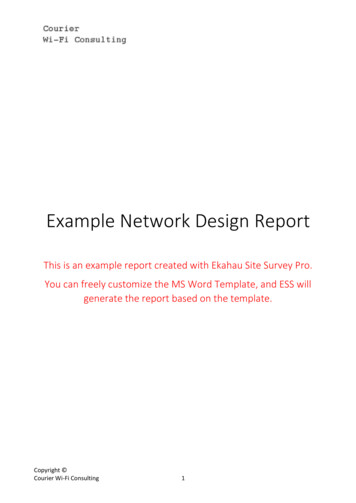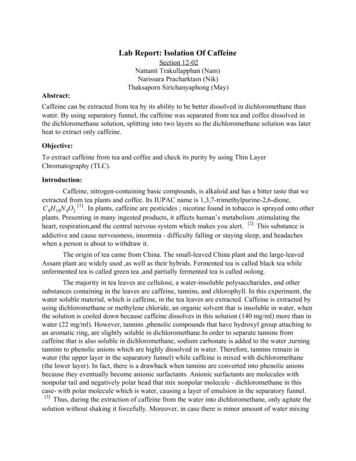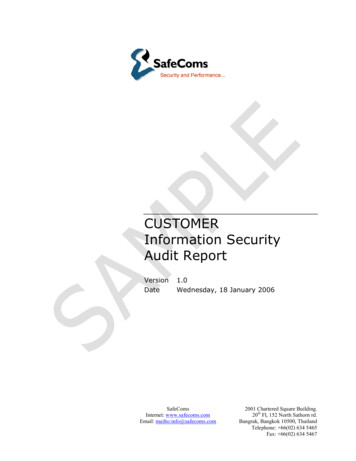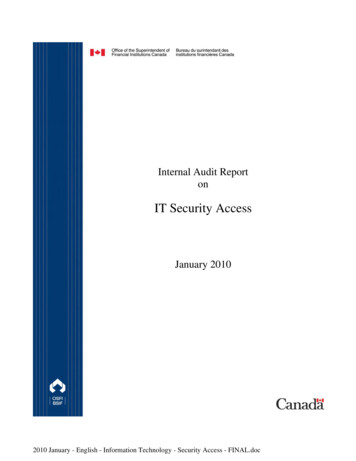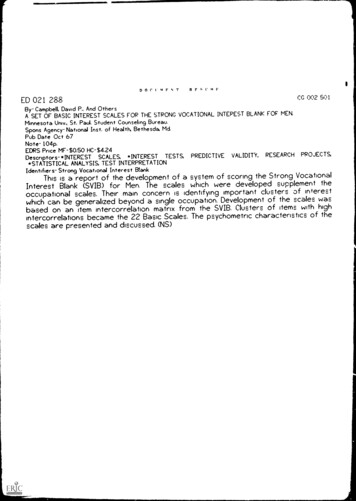
Transcription
DO rtMF-rRF SrmFCC 002 501ED 021 288By-Campbell, David P.; And OthersA SET OF BASIC INTEREST SCALES FOR THE STRONG VOCATIONAL INTEREST BLANK FOF MERMinnesota Univ., St. Paul. Student Counseling Bureau.Spons Agency-National Inst. of Health, Bethesda, MdPub Date Oct 67Note-104p.EDRS Price MF- 0.50 NC-4.24*INTEREST TESTS,*STATISTICAL ANALYSIS, TEST ers- Strong Vocational Interest BlankPREDICTIVEVALIDITY,RESEARCH PROJECTS,This is a report of the development of a system of scoring the Strong VocationalInterest Blank (SVIB) for Men. The scales which were developed supplement theoccupational scales. Their main concern is identifying important clusters of interestwhich can be generalized beyond a single occupation. Development of the scales wasbased on an item intercorrelation matrix from the SVIB. Clusters of items with highintercorrelations became the 22 Basic Scales. The psychometric characteristics of thescales are presented and discussed. (NS)
U.S. DEPARTMENT OF HEALTH, EDUCATION & WELFAREOFFICE OF EDUCATIONTHIS DOCUMENT HAS BEEN REPRODUCED EXACTLY A; RECEIVED FROM THEPERSON OR ORGANIZATION ORIGINATING IT. POINTS OF VIEW OR OPINIONSSTATED DO NOT NECESSARILY REPRESENT OFFICIAL OFFICE OF EDUCATIONPOSITION OR POLICY.A Set of Basic Tnterest Scales for theStrong Vocational Interest Blank for MenbyDavid P. CampbellFred H. BorgenSuzanne H. BastesCharles B. JohanssonRobert A. PetersonCenter for Interest leasureAent ResearchStudent Counseling BureauOffice of the Dean of 'tudentsUniversity of Minne,00taOctober, 1967
were expens ve to accumulate, andreportedinthispaperThe statisticsThe overall project was funded by themany agencies provided assistance.through Grant 1428-03, most of the computerofHealthNational Institutesof Minnesota,NumeriLal Analysis Center, Universityfurnsihe0bythetime wassupplied by the Student Counseling Bureau,cleriLalhelpwasand considerableUniversity of Minnesota.
List or TzblesPageTitleFigure7IntercorrelationsFrequency Distribution of itemA Profile ofIc Scales for the SVIB--Menand Scientist Sampit.,Test and Retest Profiles for Salesman35393TableSample SV B item Intercorrelations19Adventure Cluster210Agriculture Cluster311Art Cluster412Business Management Cluster13Law/Politics Cluster614Mathematics Cluster7Mechanical ClusterloMedical Service Cluster91710Merchandising Cluster11Military Activities Cluster181912Music Cluster13Nature Cluster2114Office Practices Cluster15Public Speaking ClusterlbRecreational Leadership Cluster232417Religious Activities Cluster18Sales Cluster19Science Cluster20Social Servi:e Cluster21Teaching Cluster22Technical Supervision Cluster23Writing Cluster/0281950
TitleTablePage3524Autonomy Cluster25Compulsivity ClusterReliabilities for Some Experimental Basic Scales3826A Listing of Cranny's vs Campbell, et al Scales4127Educational Level of Norm Group452 Job Satisfaction L : Norm Group4629Teenage and Adult Mean Scores for Bas c Scale Ncrm Group483031Basic Scale Intercorrelations32Basic Scale Means, Standard Deviations, and Test-RetestComelations for Several Samples over Varying Time Periods3336495155Basic Scale Means, Standard Deviations, and Test-RetestCorrelations for Stanford Students tested as Freshmen, Sophomol'es,After GraduationFive Years After Graduation, and Fifteen Yearswhose Basic ScaleBrief Description of the Occupational SamplesMean Scores appear in Tables 35-505934Male Occupations Mean Scores on the ADVENTURE Scale6535ScaleMale Occupations Moan Scores on the AGRICULTURE6636Male Occupations Mean Scores on the ART Scale6737MANAGEMENT ScaleMale Occupations Mean Scores on the WISINESS6838LAW/POLITICS ScaleMale Occupations Mean Scores on the6939ScaleMale Occupations Mean Scores on the MATHEMATICS70407141MECHANICAL ScaleMale Occupations Mean Scores on the7242SERVICE ScaleMale Occupations Mean Scores on the MEDICALMERCHANDISING ScaleMale Occupations Mean Scores on the7343ScaleMale Occupations Mean Scores on the MILITARY7444ScaleMale Occupations Mean Scores on the MUSIC75457646NATURE ScaleMale Occupations Mean Scores on the7747PRACTICES ScaleMale Occupations Mean Scores on the OFFICESPEAKING ScaleMale Occupations Mean Scores on the PUBLIC7848
TablePageTitle49Male Occupations Mean Scores on the RECREATIONAL LEADERSHIP Scale7950Male Occupations Mewl Scores on the RELIGIOUS ACTIVITIES Scale8051Male Occupations Mean Scores on the SALES Scale8152Male Occupations Mean Scores on the SCIENCE53Male Occupations Mean Scores on the SOCIAL SERVICE Scale8354Male Occupations Mean Scores on the TEACHING Scale8455Male Occupations Mean Scores on the TECHNICAL SUPERVISION Scale8536Male Occupations Mean Scores on the WRITING Scale8657Mean Test and Retest Profiles for the Berdie-Schletzer CurricularGroups8958Three Highest Test and Retest Means and Largest Gains for BerdieSchletzer Six Curricular Groups90Scale82
Vocational interest Blank for MenA Set of Basic Interest Scales for the StrungDavid P. Campbell, Fred H. Borgen, Su,.anne H. Eastes,Charles B. Johansscn, and Robert A. PetersonUniversity of MinnesotaVocational Interest Blank (SV1B)The regular scales now in use for the Strongof men in specific occupations with thosewere developed by comparing the responsesof a men-in-general group.Those items selected more often by the occupationalof the mensalple serve as a scale for identifying the characteristic interestsin that occupation.These are usually termed "empirical" scales, and the scoresindividual's interests and the interestsprovide an index of similarity between theof men in the specified occupations.A substantial amount of research (see, for1953; Campbell, 1966) has shown thatexample, Strong, 1943, 1953; Darley and dagenah,these scores are usefulLP psychological assessment projects and in counselingsituations.Problems with thescales is that they include all of theThe major advantage of these empiricalinterpretationdiscriminating items for each occupation in one scale; this makesfor that one occupation fairly easy.With these scores, a counselor can saysomething like, "You have interests similar to lawyers."However, the nature ofinterpretation difficult.empirical scales makes further psychologicalIf thehave interests similar to lawyers?",individual asks the obvious, "What does it mean tolawyers from other sources.the counselor must fall back on what he has learned aboutprovide some general flavor,Although the related scales on the SVIB profiledone by well-trained, sophisticatedinterpretation is still shallow except whenexperience in working with the SVIB, and whocounselors who have had considerablehave studied the research literature,
111111111.mrommiwomaillIMMEMIIIIIIIIIIA second major disadvantage is that there is no limit to tiv, number ofempirical scales; in theory one could be developed for each occupation.but thereare over 20,000 occupations listed in the Dictionary of 0upational Titles.While one can, in only partial fantasy, visualize a computerized system wherethis information would be availabl'.: for hundreds of occupations, this is still farbeyond our current capabilities.in current practice, to compensate for thisrelatively narrow coverage of the occupational world, the counselor usuallyextrapolates from the available SVIB scales to other occupations not listed onthe profile.For example, if a student inquires about geology, scores on theEngineer and Chemist scales are probably relevant.Some such extrapolation willbe inevitable, no matter what the final method used, but it should be as easy anddire:t as possible.they aro difficult toA third disadvantage of these empirical scales is thatwork with in research studies.If an investigator wisho,,, to study men who havethose who have not, he finds itsurvived in a specific occupational setting versuscumbersome to compare these two groups on all of the 60 current empirical scales.differences on each of the scales,While he can, and usually does, calculate the meanthe resulting statistics do not offer either a parsimoniousior easily interpretableinterests of these two samples.method of understanding what distinguishes between theThe empirical success of tie SV1B has created most of these problems.Becauseinterpretable score for a .specificthe scales are useful and do provide an oa!lilyoc'upation, there has heen considerable pressure to build more of them, furtherincreasivg the complexity of the profile.From all indications, this will continueas more occupations feel the need for self-study.This is good for this detailedpsychometric hiformation on a wide variety of jobs is essential, hut this prospectsimpler way to summarize the results.makes it even more imperative to develop a
3is another system of scoring toWhat both the counselor and researcher needfew scales, butsupplcment the occupational scales, a system containing relativelybeyond a single occupation.scales which could be used to generalizeVocational Interest Inventory, hasClark, in his research with the Minnesotahomogeneous inshown that one way to do this is to work with measures that arecontent (Clark, 1961).they areEach of his Homogeneous Scales (or Area scales astype of activity or in closelycalled on the profile) reflects interests in onecontent scales.related activities; thus, they are "pure"for the Men's Form of the SVIB;Such a set of scales has been constructedand of their psychometric characteristics.this is a report of their developmentof ,nterests representedBecause this was an attempt to identify the important clusterstermed "Basic Interest" scales.in the SVIB, these scales have beenBasic Scale Developentintercorrelation matrix was generated for theTo build these scales, an itemitems with high intercorrelations wereSVIB and, from this matrix, clusters ofidentified.The items in these clusters became the Basic Scales.Set (1) and Set (2) of the Basicconstructed, the first using the 291 itemsActually, two sets of scales wereof the SVIB bookletcommon to all (1927, 1933, 1938, and 1966) editions,the secondusing all 399 items of the 1966 revised form.be used in current projects, either forAlthough the first set will usually notdictated its development: first, practicallycounseling or research, three factorsstudied with either the 1927, 1933 or 1938all of the SVIB criterion groups wenhave old data on an earlier booklet andbooklets; second, many longitudinal studiespractical concern, despite the efforts ofcurrent data on a later form; third, a morewho have not yetservices, there inevitably are usersthescoringthe publisher andFor all of these situations, a sot of scalesswitched to the rev sed (l966) form.
compatible with both early and recent booklets is needed.includeThe second set of basic scales is simply the first set expanded tothe items added to the SV1B in the 1966 revision.In this revision, a definiterelatively neglected in theattempt was made to improve the coverage in areasoriginal item pool such as art, religion, and music.As a result, scales for thoseareas are longer and more adequate in the second set.Unless confronted by one ofusers of the SVIB should USQthe situations in the preceding paragraph, currentthis second set.hereare f om groups tested beforeBecause most of the normative data presentedotherwise.1966, only the Set 1 scales are used unless specifically notedEliminated Itemsitems before scale construct:onTwo restrictions were applied to the individualand unpopulvr ones, no .tem was uscdFirst, to eliminate the highly popularibegan.DISLIKL'had less than 15 percentif any of the responses, LIKE, INDIFFE1thN1, orresponse among a sample of mon-in-general.320 were included.Second, none of the items numbered 281-the respondent is toThose are the items grouped in tens wherehe likes least, and mark the remainingselect the three he likes best, the threefour indifferent.percent of the respondentsThis forwat is troublesome as one or twofill in this section incorrectly.Another one percent or so, aggravated by this iorcedthe margin and refuse to fill in anychoirn format, write some hostile comment inof the items.thee items are less efficientTo solve these problems, and becausewill propally be removed ia some futurethan the regular L-I-D items, this sectionrevision.scales.items were not used in these basicIn anticipation of that move, theseretrictions.Only a few items were affected by theseItem Intercorrelationsgenerate an item intercorrelationThe next step in scale construction was tomatrix.of 300 Men-in-General, a PearsonUsing the responses from Strong's group
5calculated between each pair of items by assigning theproduct moment correlation wasthento the LIKE, INDIFFERENT, and DISLIKE responses,and-1respectivelyvalues 1, 0,other as the Y. Examples of three such correlationstheXaxis,thetreating one item asand a high negativeincluding a high positive, a low positive,inTable1,are shownexcept betweenalmost no large negative ally created, -.19 qualifies here aswheretheywereforced-choice itemsInsert Table 1 about hereWhile we wanted toexactly how to build the scales.The next step was to decideinitially had little ideaintercorrelations,we"high"identify clusters of items withusing allknowledge here, a frequency distribution,Togainsomeof what to call high.intercorrelation matrix, was constructed; it isintheitemof the correlationsreplication, an analogous distribution is includedToprovidea1.reproduced in FigureThe two distributionsthe Women's Form of the SVIB.intercorrelationsfromfor the itemare remarkably similar.Several conclusionsdistributions in Figurecan be drawn from the1:generally low, mostly around zero,1. The item intercorrelations werepractically all between1.20.This mild effectslightly positively skewed.2. The dis,-.,Itions werefactors such as a slight response set,could be caused by any of severalof some item content areas.or over-representation3. There were not many high correlations.In the initial matrix, the"Arithmetic," andthe items "Mathema
This is a report of the development of a system of scoring the Strong Vocational. Interest Blank (SVIB) for Men. The. scales which were developed. supplement the . occupational scales. Their main concern is identifying important clusters of interest. which can be generalized beyond a single occupation. Development of the scales was. based on an item intercorrelation matrix from the SVIB .
